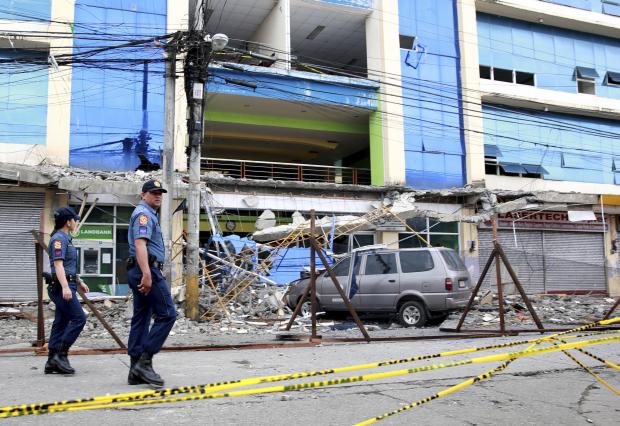Surigao is a reminder

Police officers walk past a damaged building in Surigao City, two days after it was rocked by a powerful earthquake late Friday in Surigao del Norte province in Mindanao on Sunday, Feb.12, 2017. President Rodrigo Duterte has consoled survivors of the earthquake. (Photo by REY BANIQUET/Presidential Photographers Division, Malacañang Palace via AP)
The pictures and stories coming out of Surigao City, in the wake of the powerful earthquake that struck it late Friday, are disheartening. The 6.7-magnitude temblor damaged large swaths of the city, with buildings and roads either cracked or collapsed, some 209 residents injured, and 8 people killed. At least 137 aftershocks have been recorded at this writing, further endangering weakened infrastructure and preventing residents from going back to their homes.
Water and food are the most urgent needs at this time, with the national government leading the appeal for clean water to be sent posthaste to the survivors. Nongovernment organizations and private individuals who want to send assistance may coordinate with the Department of Social Welfare and Development, it said. The quake was sufficiently strong to bust water pipes, leaving residents camping out in open areas or braving it in their homes without running water.
The quake also damaged 12 schools, six bridges and business establishments such as shopping malls and hotels, “many of which had visible cracks, shattered glass windows and damaged canopies,” according to a report in this paper. Provincial information officer Mary Escalante said in a TV interview that some school buildings and gyms designated as evacuation centers also sustained damage. And the city airport was closed due to a cracked runway, delaying the arrival of President Duterte, who, accompanied by Social Welfare Secretary Judy Taguiwalo, flew to Surigao on Sunday and pledged P2 billion for rehabilitation efforts, specifically for the medical needs of injured survivors.
The aftershocks will continue, and “these may last for days, up to weeks,” said Renato Solidum of the Philippine Institute of Volcanology and Seismology. This means the people of Surigao will continue to live anxious, sleepless days for some time, as every tremor rouses them to brace for further damage in their homes or establishments, and to wonder whether to head for safer ground every time to spare themselves and their loved ones any risk of injury. The government has sent emergency relief to Surigao, but more is needed in the coming days and weeks as the residents are forced to live with this state of uncertainty.
Another appeal has gone out from the National Disaster Risk Reduction and Management Council—for volunteer engineers to fan out and help check whether buildings, houses, offices, and especially hospitals are stable enough for people to go back to. The NDRRMC’s recommendation is for residents not to return immediately to buildings and homes after a strong quake—at least not until such infrastructure has been checked for stability. But the inspection of every house, school, hospital, hotel, mall and other buildings all over the affected area by qualified personnel would require enormous manpower, so “we are again reiterating our appeal for help from civil and structural engineers to ensure the safety of our people,” said NDRRMC spokesperson Romina Marasigan.
After Surigao has been helped back on its feet, that call should also be made for the vastly bigger area of Metro Manila, which, experts have been warning for some time now, is due for the Big One. The West Valley Fault, a 100-kilometer fault that runs through six cities in the metro and nearby provinces, is said to move
every 400-500 years. With the last fault quake recorded in 1658, or 357 years ago, “it may be time soon for another major movement in the fault,” according to a July 2015 report in this paper.
The Metropolitan Manila Earthquake Impact Reduction Study paints a staggering scenario once, say, a 7.2-magnitude temblor hits Metro Manila: “It will result in the collapse of 170,000 residential houses and the death of 34,000 people. Another 114,000 individuals will be injured while 340,000 houses will be partly damaged.”
Surigao is a reminder: Now is the time for utmost preparation.




















